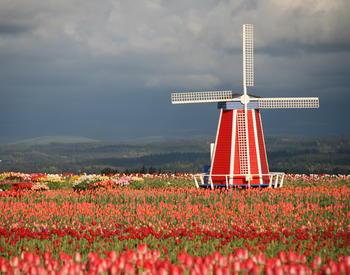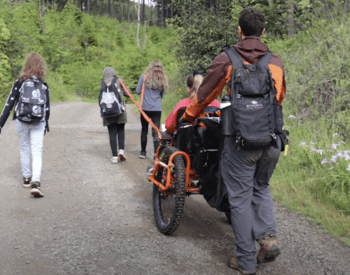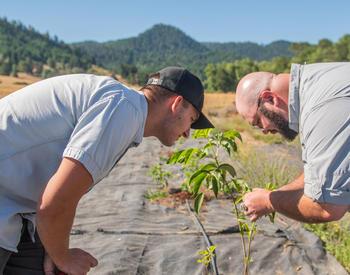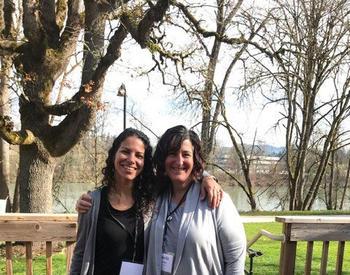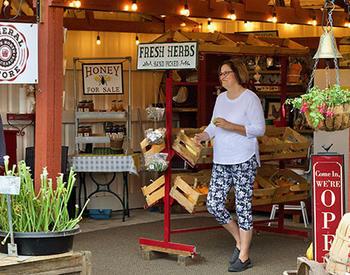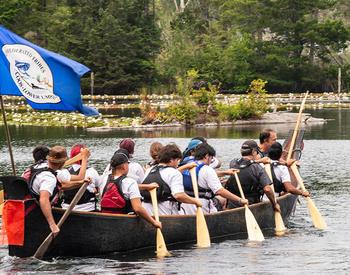OREGON CITY, Ore. – The Molalla Log House, which has stood for centuries in the foothills of the Cascades, is getting a new life – and the public will be learning about its rebirth thanks to the Oregon State University Extension Service.
The house, possibly the oldest pioneer dwelling in Oregon history, is being reassembled in the Hopkins Demonstration Forest with a combination of the original and restored hand-hewn logs.
Visitors are welcome walk the trails at Hopkins to view the process of reconstruction, but are asked to stay behind the yellow taped area for safety reasons. Once the first floor is complete the structure will be tarped off for the winter. Next summer the second floor will be stacked and the roof will be constructed.
“We educate about the use of wood and the Molalla Log House is the perfect example of bringing the past into the future here in Oregon and why managing our forests ties all that together,” said Peter Matzka, Oregon State University Extension Service forestry educator at Hopkins Demonstration Forest.
The goal is to finish the house by the fall of 2020, when it will be open for scheduled tours. According to Matzka, the staff at Hopkins is exploring interactive educational opportunities for the public and the thousands of students that visit the demonstration forest each year.
OSU Extension in Clackamas County helped form the nonprofit that operates the Hopkins Demonstration Forest. Matzka manages the educational programs at Hopkins.
The Molalla Log House was found in south Molalla in 1984, attracting the attention of historians who discovered it had been dismantled and moved from an unknown original location in 1892. The craftsmanship was unlike any other pioneer construction in Oregon. The logs are meticulously hand-hewn with notched and fitted corners that sit flush against each other like a puzzle, locking it all together securely without the use of nails.
Pam Hayden, an architectural historian who began studying the log house in 1984 and is leading the rebuilding of the house, said its origins will most likely always remain a mystery. For the last 12 years, project researchers have gleaned some understanding about the building based on clues from its design and construction, dendrochronology and log-end erosion studies. They've combed through local legends and conducted extensive research of documented historical records spanning the North American continent.
“The building may be the product of skilled craftsmen who learned this technique of building from eastern roots in the U.S. and Canada," Hayden said." They may have been enlisted by a British/Canadian fur company as freemen hunters to explore new hunting territories west of the Rocky Mountains, in the Columbia River Basin."
Because of its craftsmanship, design and rarity it was designated by the Board of County Commissioners as a Clackamas County Historic Landmark in the 1990s, Hayden said.
Even with its landmark designation, by 2007, the house was in bad shape. The roof had collapsed and the logs were deteriorating. Hayden contacted Gregg Olson, an expert in rehabilitating log buildings in Oregon. They determined that the structure needed to be dismantled again in order to be saved. It was carefully disassembled piece by piece and moved to a storage facility where it was analyzed, preserved and restored. The team determined the age range of the house by studying tree rings on the logs, and the search for a new home began.
“The first thing we did was go out into the woods and re-hew the logs that couldn’t be saved,” said Olson. “We spent over a year dovetailing the new logs and patching the old ones.”
The logs were stacked back together in a shop to solve any construction problems and make it easier to reassemble the structure on the Hopkins site, where some of the new wood pieces were harvested.
Hopkins Demonstration Forest is operated by Forests Forever Inc. The Forest Forever board of directors, which includes OSU Extension foresters Mike Bondi and Glenn Ahrens, was intrigued by the log house story and its depiction of the history of the family forestry movement in Oregon in conjunction with the use of wood products in sustainable construction today. In 2017, the board approved the re-homing of the Molalla Log House on the Hopkins site.
“We are very fortunate to have Hopkins Demonstration Forest as the home for this building,” Hayden said. “It is the perfect setting here in the forest, possibility very similar to the historic context of where the structure was originally built.”
Hayden said most of the funding for the building rehabilitation and reconstruction has come from the Kinsman Foundation.
